Triton (Neptune)
Contents
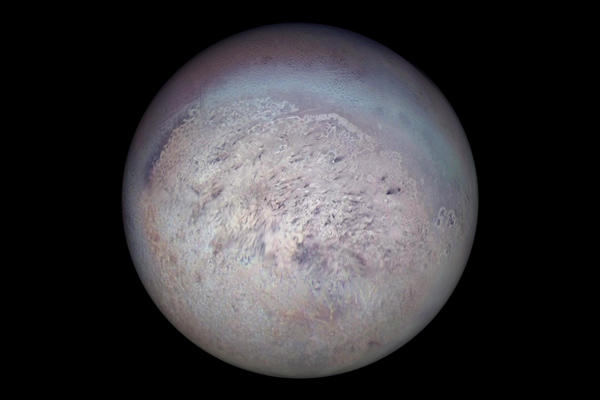 Global orthographic view of Triton / wikimedia.org
Global orthographic view of Triton / wikimedia.orgThe moon that may not have always been a moon, there is much debate over this on Triton. It's unusual surface and strange orbit suggests that Triton may not have originally been a moon of or formed with its parent Neptune. Too many variables point to the idea that Triton may have been formed elsewhere and somehow got caught up in Neptune's pull to become a part of its moon system. Some even suggest that Neptune may have been a dwarf planet reeled in by Neptune's attraction to be forever locked into its grip.
Discovery
Triton was discovery 17 days after its parent planet Neptune in 1846 by William Lassell. A successful brewer turned astronomer after Neptune was discovered, John Herschel contacted Lassell as he was improving the lenses on this telescope and suggested he search Neptune for any moons. Heeding Herschel's advice Lassell began looking around the area of Neptune and spotted Triton in its orbit.
Position to Neptune
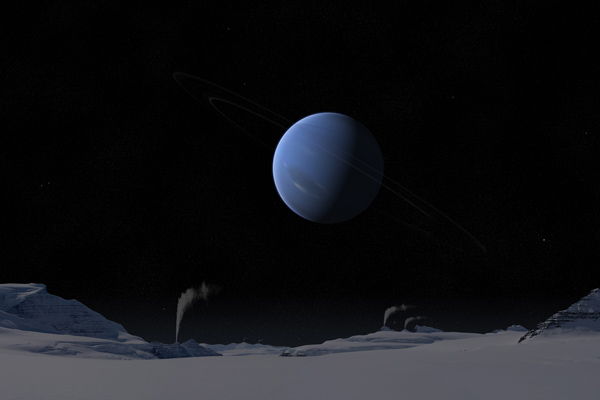 Artist's impression of Neptune View from Titan / deviantart.com
Artist's impression of Neptune View from Titan / deviantart.comTriton is located approximately 354,759 km (219,965 miles) from Neptune at an inclination of 129.6°. It takes approximately 5.9 hours for it to complete its retrograde (backward) orbit around Neptune and is tidally locked so that only one face is seen from Neptune at all times. Its orbit is also near circular and is disintegrating. It is slowly moving closer to Neptune and it is believed within a few billion years will either move close enough to be torn apart by Neptune's or will be pulled into Neptune's strong gravity to crash into its surface.
Internal Structure
Because of it's mass of 2.14×1022 kg and density of 2.066 grams per cubic centimeter, it is strongly believed that Triton possesses a large rocky core covered in ice with maybe a little liquid water present. This is speculation at this time as there is very little data to confirm or deny this theory and no future closer exploration of Triton have been planned.
Surface/Geography
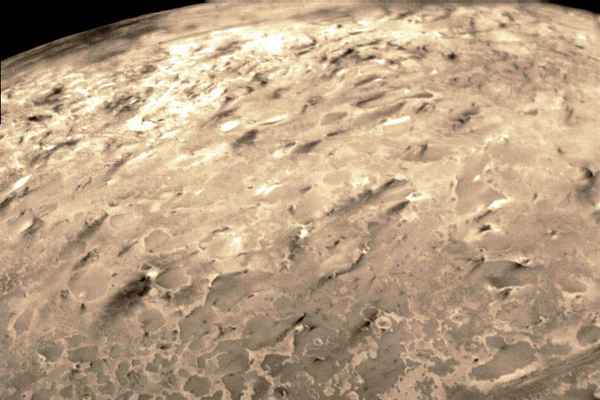 Dark streaks across Triton's south polar cap surface / wikipedia.org
Dark streaks across Triton's south polar cap surface / wikipedia.orgTriton has very similar characteristics to a dwarf planet, such as Pluto which leads scientist to believe, along with its odd orbit, that Triton was a captured moon that may have been part of a proto-planetary system from the Kuiper Belt. Spectra images of Triton from the Voyager 2 flyby show that its surface is covered in ice and snow, which accounts for its high reflective nature along with its thin atmosphere. Surface temperatures drop to a staggering -235°C (-391°F) below zero making it the coldest object in our solar system thus far.
It's tilted rotation on its axis allows for Triton to have seasons as one pole is facing the sun more so than the other during its orbit. During the summer, its atmosphere appears to thicken showing that gasses are being thawed and released from the surface adding more material. This keeps its the elements in its atmosphere and surface in constant renewal.
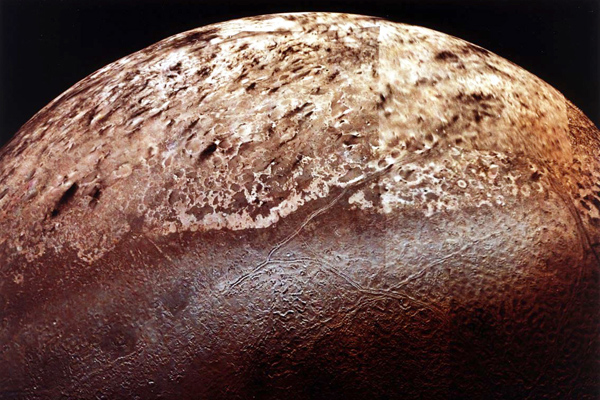 Triton's bright south polar cap above a region of cantaloupe terrain / nasa.gov
Triton's bright south polar cap above a region of cantaloupe terrain / nasa.govImages from Voyager 2 in 1989 showed that Triton consisted of flat surfaces, rocky outcrops, canyons, active geysers, and a few impact craters. The lack of impact craters shows that its surface is fairly young and the active geysers which shoot out ice as distant as 5 miles (8 km) into the air show that there is still geological activity occurring.
Atmosphere/Climate
Triton's atmosphere is very thin. It primarily consists of nitrogen and methane extending up to 800 km (500 miles) from its surface due to its weak gravity. If you were to weigh 68.0 kg (150 lbs) on Earth, you would weigh 5.4 kg (11.9 lbs) on Triton. That is how weak Triton's gravity is. This makes it difficult for this moon to maintain its atmosphere and suggest that since it has one, albeit as thin as it is, that there is some sort of geological activity that is renewing it.
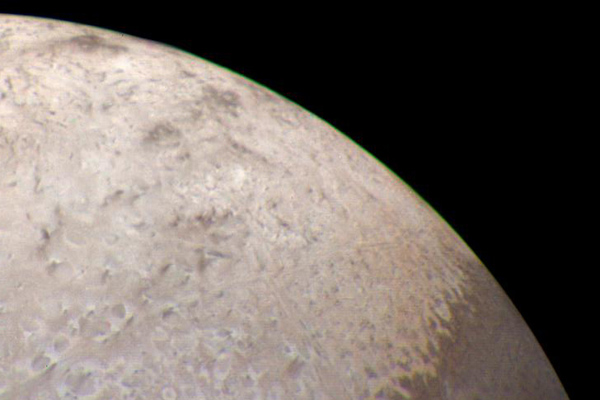 The Limb of Triton / nasa.gov
The Limb of Triton / nasa.govBecause of Triton's high albedo of 0.76, 60% to 95% of the sunlight that hits the moon is reflected back into space. Atmospheric pressure at the surface is approximately 14 microbars and the temperature at the highest point of its atmosphere, 800 km (500 miles), is about -178.9°C (-290°F).
Seasonally, Triton's atmosphere appears to thin and thicken. As it approaches its summer equinox, the gasses increase the atmosphere thickens while during its winter equinox those gasses begin to freeze and fall back to the surface and the atmosphere thins. This is due to its orbital tilt on its axis at 157°.
Exploration
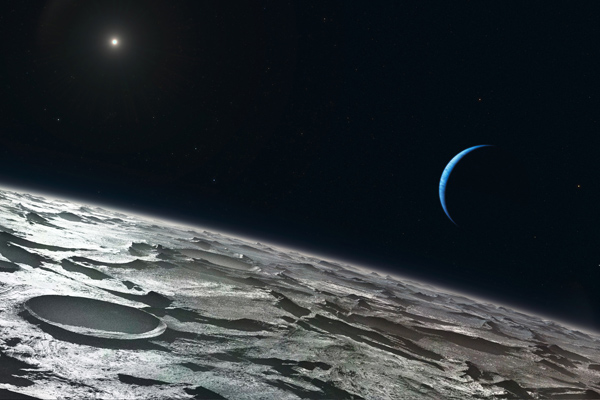 Artist's impression of Triton, showing its tenuous atmosphere just over the limb / eso.org
Artist's impression of Triton, showing its tenuous atmosphere just over the limb / eso.orgCurrently, there are no missions planned for Triton for the future and only one probe has ever visited Triton, the Voyager 2. Voyager 2 showed that Triton is still geologically active with geysers renewing atmosphere and resurfacing its surface, covering up impact zones. Though there is interest in learning more about this unusual moon, scientist have consigned to observing it through Earth-Bound telescopes rather than funding for a mission to explore Triton further.
See also: All satellites and moons, Neptune's satellites and moons, Neptune, Objects
Video Gallery

-
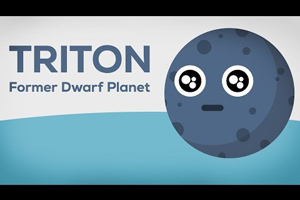 How to catch a Dwarf Planet - Triton
How to catch a Dwarf Planet - Triton
-
 Triton: The Celestial "Cantaloupe"
Triton: The Celestial "Cantaloupe"
-
 Universe Sandbox 2 - Terraforming Triton
Universe Sandbox 2 - Terraforming Triton
-
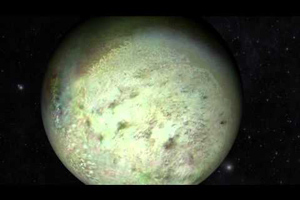 Sailing Past Neptune's Moon Triton
Sailing Past Neptune's Moon Triton